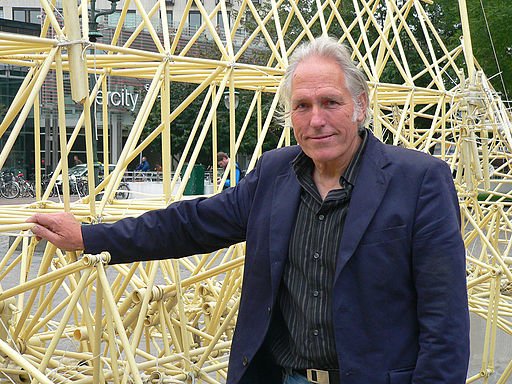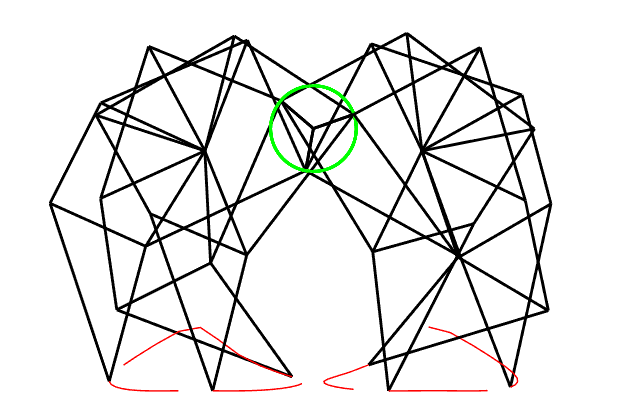How the kinetic sculptures of the beaches of Holland work
Hello my dear friends!
On this occasion, I want to share with you something very interesting that is worth commenting on.
Imagine that you are walking peacefully along the shores of the beautiful beaches of Holland and suddenly find something like what the following video of Youtube shows. See it, you will like it.
When I saw these strange sculptures move, the first thing I thought was: What are they? What are they made of? How do they work? Well, dear reader, we are going to answer these and other questions.
What are they?
These imposing looking sculptures that simulate skeletons of strange animals are known as "Strandbeest". They owe their name to its creator, the renowned Dutch artist Theo Jansen, who is the gentleman that is seen in the video with them.
Who is the creator of these kinetic sculptures?
Jansen studied physics at the University but left these studies unfinished to dedicate to art. He participated in several art and technology projects before starting to create his Strandbeests in 1990. His first creations were a flying saucer made with PVC tubes and filled with helium, which flew over the city of Delft in 1980 and a painting machine that could it detect the darkness of the person who was in front of it and then paints their silhouette.
In his own words, Theo Jansen considers that:
"The walls between art and engineering exist only in our minds."

Wikimedia Commons – Public domain
Polyhedral structures of pipes for electrical installations
That yellow material that imprints a bone aspect to the sculptor Jansen's walking skeletons is PVC tubes. If my dear reader, these tubes are used for electrical installations in the Netherlands, there are plenty of them and it is a very economical, resistant and light material. In addition, it uses adhesive tape, flanges, wood and fabric for the aerodynamic profiles.

Pixabay - CC0 Creative Commons
How do they function?
To better understand how they function, let's start by knowing how are they constituted.

Wikimedia Commons - CC BY-SA 3.0
The main parts are the wings, a crankshaft and the legs of the beast. Additionally, its creator has designed other components which he has called "lungs", "stomach", "brains," "tentacles" and hammers. All generations of beasts are created with a system of triangles and linkages.
The wings move with the energy of the wind and activate the crankshaft which, when rotated, transmits movement to the legs, allowing them to move on the sand of the beach.
And if there is no wind they do not move?
Yes they can move, aided by a mechanism made of plastic bottles filled with compressed air.
The key to movement is in the legs. The design of the same is governed by what the artist called the "holy numbers", which are nothing more than lengths of the tubes necessary to the legs for the mechanism can move.

Strandbeest--Full-Walking by Michael Frey
Wikimedia Commons - CC BY-SA 3.0

Wikimedia Commons - CC BY-SA 3.0
holy numbers?
They are the lengths that each leg must have in order to move and it is repeated in each model that has been created.

Wikimedia Commons - CC BY-SA 3.0
These values were obtained by Jansen using genetic algorithms, inserting a certain criterion (They can survive by moving between the beach and the dunes), simulating the environment and selecting the designs with higher performance. Through trial and error, he managed to make each model superior to the previous one.
Optimizing each generation
Each model or generation as Jansen calls them, donate to be hybridized, their mobile parts that work best for the next generation, making each new sculpture more capable of stay in the environment (hybridization and evolution).
Also, each of the sculptures has a mechanism that allows them to detect water and also the threat of strong winds. In the first case, the Strandbeest walks in the opposite direction to the water and in the case of strong winds, it nails a wedge in the sand that prevents it from tipping over.
How long does each kinetic sculpture work?
The time of operation of each sculpture begins with its construction, then it is taken to the beach to put it to the test and finally, it returns to the workshop where it is deposited as a fossil, and then a new cycle of creation of a new species begins to improve the faults present in this model.
Some species created o Animaris
If you want to see how some of the Strandbeest species that have been created work, I invite you to watch the following videos:
- Animaris mulus
- Animaris gubernare
- Animaris turgentia
- Animaris Plaudens Vela
- Animaris Siamesis
- Animaris Umerus
- Animaris Rhinoceros
With this, I finalize this publication hoping that it has been of your liking and interest. I say goodbye until a next opportunity, thanking as always your time and your kind attention.
Thank you very much, dear reader!
References
- http://tuplanetavital.org/tag/bestias-de-playa/
- http://artishockrevista.com/2018/05/14/algoritmos-del-viento-theo-jansen-y-la-necesidad-de-imaginar/
- https://en.wikipedia.org/wiki/Evolutionary_computation
- http://www.strandbeest.com/beests_leg.php
- https://cpb-us-e1.wpmucdn.com/blogs.cornell.edu/dist/c/2461/files/2012/09/Theo-Jensen-The-Great-Pretender-Pregluton-Gluton-2bmvr25.pdf
This post has been voted on by the SteemSTEM curation team and voting trail in collaboration with @curie.
If you appreciate the work we are doing then consider voting both projects for witness by selecting stem.witness and curie!
For additional information please join us on the SteemSTEM discord and to get to know the rest of the community!
Thanks for the support. The witnesses have already voted and I joined to Discord some time ago. I love what they do. Congratulations!